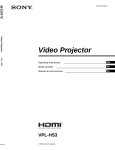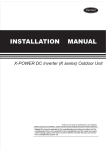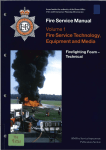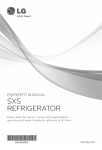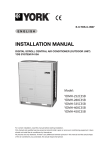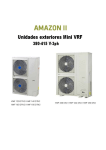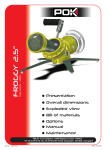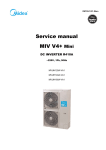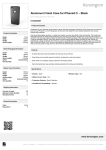Download INSTALLATION MANUAL
Transcript
INSTALLATION MANUAL DC INVERTER FREE Thank you very much for purchasing our air conditioner, Before using your air conditioner, please read this manual carefully and keep it for future reference. CONTENTS PAGE PRECAUTIONS........................................................................................1 ATTACHED FITTINGS..............................................................................2 Accordingly the exclusive tools are required for the new refrigerant (R410A): For connecting pipes, use new and clean piping designed for R410A,and please care so that water or dust does not enter. Moreover, do not use the existing piping because there are problems with pressure-resistance force and impurity in it. OUTDOOR UNIT INSTALLATION..............................................................3 INSTALL THE CONNECTING PIPE............................................................4 CAUTION ELECTRICAL WIRING..............................................................................9 Do not connect the Appliance from Main Power Supply. TEST RUNNING.....................................................................................11 PRECAUTIONS ON REFRIGERANT LEAKAGE.........................................12 TURN OVER TO CUSTOMER..................................................................12 CUSTOMER DETAILS............................................................................13 This unit must be connected to the main power supply by means of a switch with a contact separation of at least 3 mm. The installation fuse must be used for the power supply line of this conditioner. WARNING 1. PRECAUTIONS Ensure that all Local, National and International regulations are satisfied. Read this ”PRECAUTIONS ” carefully before Installation. The precautions described below include the important items regarding safety. Observe them without fail. After the installation work, perform a trial operation to check for any problem. Follow the Owner’s Manual to explain how to use and maintain the unit to the customer. Turn off the main power supply switch (or breaker) before maintenance the unit . Ask the customer that the Installation Manual and the Owner’s Manual should be kept together . CAUTION New Refrigerant Air Conditioner Installation THIS AIR CONDITIONER ADOPTS THE NEW HFC REFRIGERANT(R410A)WHICH DOES NOT DESTROY OZONE LAYER. The characteristics of R410A refrigerant are; Hydrophilic, oxidizing membrane or oil, and its pressure is approx.1.6 times higher than that of refrigerant R22.Accompanied with the new refrigerant, refrigerating oil has also been changed ,Therefore, during installation work, be sure that water, dust, former refrigerant, or refrigerating oil does not enter the refrigerating cycle. To prevent charging an incorrect refrigerant and refrigerating oil, the sizes of connecting sections of charging port of the main unit and installation tools are charged from those for the conventional refrigerant. Ask an authorized dealer or qualified installation professional to install/maintain the air conditioner. Inappropriate installation may result in water leakage,electric shock or fire. Turn off the main power supply switch or breaker before attempting any electrical work. Make sure all power switches are off.Failure to do so may cause electric shock. Connect the connecting cable correctly. If the connecting cable is connected in a wrong way, electric parts may be damaged. When moving the air conditioner for the installation into another place, be very careful not to enter any gaseous matter other than the specified refrigerant into the refrigeration cycle. If air or any other has is mixed in refrigerant, the gas pressure in the refrigeration cycle becomes abnormally high and it may resultingly causes pipe burst and injuries on persons. Do not modify this unit by removing any of the safety guards or by by-passing any of the safety interlock switches. Exposure of unit to water or other moisture before installation may cause a short-circuit of electrical parts. Do not store it in a wet basement or expose to rain or water. After unpacking the unit, examine it carefully if there are possible damage. Do not install in a place that might increase the vibration of the unit. To avoid personal injury (with sharp edges), be careful when handling parts. Perform installation work properly according to the Installation Manual. Inappropriate installation may result in water leakage, electric shock or fire. When the air conditioner is installed in a small room, provide appropriate measures to ensure that the concentration of refrigerant leakage occur in the room does not exceed the critical level. Install the air conditioner securely in a location where the base can sustain the weight adequately. Perform the specified installation work to guard against an earthquake. If the air conditioner is not installed appropriately, accidents may occur due to the falling unit. If refrigerant gas has leaked during the installation work, ventilate the room immediately. If the leaked refrigerant gas comes in contact with fire, noxious gas may generate. After the installation work, confirm that refrigerant gas doer not leak. If refeigerant gas leaks into the room and flows near a fire source, such as a cooking range, noxious gas might generate. Electrical work must be performed by a qualified electrician in accordance with the Installation Manual. Make sure the air conditioner uses an exclusive power supply. installation manual 1 An insufficient power supply capacity or inappropriate installation may cause fire. Use the specified cables for wiring connect the terminals securely fix. To prevent external forces applied to the terminals from affecting the terminals. Be sure to provide grounding. Do not connect ground wires to gas pipes, water pipes, lightning rods or ground wires for telephone cables. Conform to the regulations of the local electric company when wiring the power supply. Inappropriate grounding may cause electric shock. Do not install the air conditioner in a location subject to a risk of exposure to a combustible gas. If a combustible gas leaks, and stays around the unit, a fire may occur. Required tools for installation work 1) Philips screw driver 2) Hole core drill(65mm) 3) Spanner 4) Pipe cutter 5) Knife 2. 6) Reamer 7) Gas leak detector 8) Tape measure 9) Thermometer 10) Mega-tester 11) Electro circuit tester 12) Hexagonal wrench 13) Flare tool 14) Pipe bender 15) Level vial 16) Metal saw 17) Gauge manifold (Charge hose:R410A special requirement) 18) Vacuum pump (Charge hose:R410A special requirement) 19) Torque wrench 1/4(17mm)16N•m (1.6kgf•m) 3/8(22mm)42N•m (4.2kgf•m) 1/2(26mm)55N•m (5.5kgf•m) 5/8(15.9mm)120N•m (12.0kgf•m) 20) Copper pipe gauge adjusting projection margin 21) Vacuum pump adapter ATTACHED FITTINGS Please check whether the following fittings are of full scope. If there are some spare fittings , please restore them carefully. NAME INSTALLATION FITTINGS 2 QUANTITY 1. Outdoor unit installation manual 1 2. Outdoor unit owner’s manual 1 3. Indoor unit owner’s manual 1 4. Installation Instructions: Indoor Unit Manifold 1 5.Water outlet connection pipe 1 6.Straight screwdriver 1 7.Sealing ring 1 8.Waterproof chassis cover 2 9.Connection pipe(26kW) 1 10.Curved connection pipe(26kW) 1 Refrigerant Piping Piping kit used for the conventional refrigerant cannot be used. Use copper pipe with 0.8 mm or more thickness for φ9.5. Use copper pipe with 1.0 mm or more thickness for φ15.9. Use copper pipe with 1.0 mm or more thickness for φ19.0. Flare nut and flare works are also different form those of the conventional refrigerant.take out the flare nut attached to the main unit of the air conditioner, and use it. Before installation Be careful to the following items before installation. Air purge For air purge, use a vacuum pump. Do not use refrigerant charged in the outdoor unit for air purge. (The refrigerant for air purge is not contained in the outdoor unit.) Electrical cabling Be sure to fix the power cables and indoor/outdoor connecting cables with clamps so that they do not contact with the cabinet, etc. installation manual SHAPE Installation Place A place which provides a specified space around the outdoor unit. A place were the operation noise and discharged air are not given to your neighbors. A place that is not exposed to a strong wind. A place that does not block a passage. When the outdoor unit is installed in an elevated position, make sure it's four feet securely installed. There must be sufficient space for carrying in the unit. A place where the drain water does not make any problem. CAUTION Install the outdoor unit at a place where discharge air is not blocked. When an outdoor unit is installed in a place that is always exposed to a strong wind like a coast or on a high storey of a building, secure a normal fan operation by using a duct or a wind shield. The insulation of the metal parts of the building and the air conditioner should comply with the regulation of National Electric Standard. When installing the outdoor unit in a place that is constantly exposed to a strong wind such as the upper stairs or rooftop of a building, apply the windproof measures referring to the following examples. Install the unit so that its discharge port faces to the wall of the building. Keep a distance 3000mm or more between the unit and the wall surface. Do not mount the outdoor unit on a wall. CAUTION Keep indoor unit, outdoor unit, power supply wiring and transmission wiring at least 1 meter away from televisions and radios. This is to prevent image interference and noise in those electrical appliances. (Noise may be generated depending on the conditions under which the electric wave is generated, even if 1 meter is kept.) 3.2 Installation space (Unit:mm) 3000 Strong wind 1558 Fig.2-1 Supposing the wind direction during the operation season of the discharge port is set at right angle to the wind direction. Strong wind 1120 414 400 528 205.8 494 668 Fig.2-2 Fig.3-1 Single unit installation (Wall or obstacle) Air inlet > 300 Installation in the following places may result in some troubles. Do not install the unit in such places below. A place full of machine oil. A place full of sulphuric gas. A place where high-frequency radio waves are likely to be generated as from audio quipment, welders, and medical equipment. >300 Maintain the electric wire and pipeline Air inlet OUTDOOR UNIT INSTALLATION >3000 3. >600 Air outlet 3.1 Installation place Please keep away from the following place, or malfunction of the machine may be caused: Fig.3-2 Parallel connect the two units or above There is combustible gas leakage. There is much oil (including engine oil) ingredient. >300 >600 There is salty air surrounding(near the coast) There is caustic gas (the sulfide, for example) existing in the air (near a hotspring) A place the heat air expelled out from the outdoor unit can reach your neighbor’s window. A place that the noise interferes your neighbors every day life. A place that is too weak to bear the weight of the unit >3000 Fig.3-3 Parallel connect the front with rear sides >3000 >1000 >6000 >4000 >300 Uneven place. Insufficient ventilation place. Near a private power station or high Frequency equipment. Install indoor unit, outdoor unit, power cord and connecting wire at least 1m away from TV set or radio to prevent noise or picture interference. Fig.3-4 installation manual 3 4. 3.3 Moving and installation Check whether the height drop between the indoor unit and outdoor unit, the length of refrigerant pipe, and the number of the bends meet the following requirements: >600 Since the gravity center of the unit is not at its physical center, so please be careful when lifting it with a sling. Never hold the inlet of the outdoor unit to prevent it from deforming. Do not touch the fan with hands or other objects. Do not lean it more than 45°, and do not lay it sidelong. Make concrete foundation according to the sepecifications of the outdoor units.(refer to Fig.3-5) Fasten the feet of this unit with bolts firmly to prevent it from collapsing in case of earthquake or strong wind. (refer to Fig.3-5) INSTALL THE CONNECTING PIPE Fig.4-1 Fix with bolt 4.1 Refrigerant piping CAUTION Fig.3-5 NOTE All the pictures in this manual are for explanation purpose only. They may be slightly different from the air conditioner you purchased(depend on model).The actual shape shall prevail. The indoor and outdoor connecting pipe interface and power line outlet 3.4 Centralized Chassis Drainage When the outdoor unit requires centralized drainage, install the chassis and two waterproof covers for the chassis, as shown in Figure 3.6. Install the water outlet union pipe and sealing ring on the chassis, and then connect the drainage pipe to complete centralized drainage installation. Waterproof chassis cover Please pay attention to avoid the components while connect to the connecting pipes. To prevent the refrigerant piping from oxidizing inside when welding, it is necessary to charge nitrogen, or oxide will chock the circulation system. Vavious piping and viring patterns can be selected,such as out from the front ,the back the side ,and undersurface, etc.The follow display the locations of several piping and wiring knock-off interfaces Table 4-1 Sealing ring for the water outlet union pipe Front out pipe Side out pipe CAUTION Fig.3-6 CAUTION While installing the outdoor unit, pay attention to the installation place and the drainage pattern; if it’s installed at the alpine zone, the frozen condensed water will block up the water outlet, please pull out the rubber stopper of the reserve water outlet. If that still fails to satisfy for the water draining, please knock open the other two water outlets, and keep the water can drain in time. Pay attention to the knock the reserve water outlet from outside to inside, and it will be beyond repair after knocking open, please pay attention to the installation place, lest cause the inconvenience. Please do the moth proofing for the knocked out hole, to avoid the pest processing into and destroy the components. installation manual 4 1. Side out pipe: cut the side hole of the pipe-outlet plate selectively. It is suggested to cut a piece of metal plate below to avoid the mouse come and destroy the machine wiring body. 2.Front out pipe: cut the frontal hole of the pipe-outlet plate selectively. It is suggested to cut a piece of metal plate right side to avoid the mouse come and destroy the machine wiring body. 3. Wiring of power cord: the strong and weak electrical wire should be out through the two plastic holes of the pipe-outlet plate, and binded with gas and liquid pipe together. 4.2 Leak Detection Use soap water or leak detector to check every joint whether leak or not (Refer to Fig.4-2).Note: A is low pressure side stop valve B is high pressure side stop valve C and D is connecting pipes interface of indoor and outdoor units The second connect methond Check point of outdoor unit D C Outdoor Unit(Take Model 26kW for example) A B Check point of indoor unit 1 D / Fig. 4-2 / $ % / 4.3 Heat Insulation / The first Line Branch Pipe & Do the heat insulation to the pipes of air side and liquid side separately. The temperature of the pipes of air side and liquid side when cooling, for avoiding condensation please do the heat insulation fully. The air side pipe should use closed cell foamed insulation material, which the fire-retardant is B1 grade and the heat resistance over 120°C. When the external diameter of copper pipe≤Φ12.7mm, the thickness of the insulating layer at least more than 15mm; When the external diameter of copper pipe≥Φ15.9mm, the thickness of the insulating layer at least more than 20mm. Please use attached heat-insulating materials do the heat insulation without clearance for the connecting parts of the indoor unit pipes. Cut from upward 4.4 Connecting method I Table 4-2 pipe connect position code The pipe between outdoor unit to the first branch of indoor unit. / The main pipes of indoor unit The pipe after the first branch do not drect connect with the indoor unit. The branch pipes of indoor unit The pipe after the branch connect with DEF GHI the indoor unit. Indoor unit branch pipes components The pipes connect with the main pipeǃ $%& the branch pipe and the the main pipe '( of indoor unit. NOTE The distance between the first buranch to the last indoor unit is more than 15m,choose the second connect methond. The pipe between the indoor unit to the closest branch must less than 15m. /Њ/ / D The first Line Branch Pipe % E & F / ' G I ( Applicable manifold %-)&0L ¢ ¢ ¢ ¢ %-)&0L ŏ$ψ ¢ ¢ %-)&0L ŏ$ ¢ ¢ %-)&0L 4.5 Confirmation for the diameters of outdoor unit connecting pipes Table 4-4 R410A outdoor unit connecting pipes diameters Main pipe size when the totTotal capaal equivalent piping length city of The of liquid + air side is <90m outdoor Air side Liquid si- The first Line units de(mm) Branch Pipe Main pipe size when the total equivalent piping length of liquid + air side is ≥90m Air side Liquid si- The first Line Branch Pipe (mm) de(mm) Φ15.9 Φ9.5 BJF-224-CM(i) Φ19.1 Φ9.5 BJF-224-CM(i) ŏ$ψ Φ19.1 Φ9.5 BJF-224-CM(i) Φ22.2 Φ9.5 BJF-330-CM(i) ŏ$ψ Φ22.2 Φ9.5 BJF-330-CM(i) Φ25.4 Φ9.5 BJF-330-CM(i) $ψ / Main pipe size (mm) Air pipe Liquid pipe $ψ The first connect methond Outdoor Unit Table 4-3 ŏ$ψ (mm) / 1 Fig. 4-5 Capacity of the downstream indoor unit $ 1 R410A Indoor unit connecting pipes diameters Select refrigerant pipe / H ( 1) R410A Indoor unit connecting pipes diameters 4-3DŽ 2) Example 1˖In the Fig.4-5,The downstream inner units of the L2,and its total capacity is 45×2˙90ˈrefers to the Table 4.4,the air/liquid side of L2 is˖Φ15.9/Φ9.5DŽ Fig. 4-3 main pipe 1 G Size of main pipe and corresponding branch joint and branch header Affiliated heat pump belt pipe definition ' / 1 F 4.4 Confirmation for the diameters of indoor unit connecting pipes Site pipe side The unit body intdoor Units 1 E H NOTE Fig. 4-4 The straight distance between copper pipe turning and the contiguous branch pipe is at least 0.5m; The straight distance between the contiguous branchpipes is at least 0.5m; The straight distance which the branch pipes connected to the indoor unit is at least 0.5m; installation manual 5 Branch header must be connected with indoor units directly, the further branch connection is not allowed. Table 4-8 Outdoor Unit (kW) Select branch joint Select the branch joint according to the total designed capacity of indoor units which it connects to. If this capacity is more than that of the outdoor unit, then select the connection according to the outdoor unit. The selection of branch header depends on the quantity of branches it connects to. Connection method Table 4-5 Air side Liquid side 20kW Welding or Flaring Welding or Flaring 22.4kW Welding or Flaring Welding or Flaring 26kW Welding or Flaring Welding or Flaring Indoor unit Flaring Flaring Branch pipe Welding or Flaring Welding or Flaring R410A 7 10 50%~130% 22.4 8 11 50%~130% 26 9 12 50%~130% The indoor unit capacity total can not exceed 130% of the outdoor unit load. Overloading reduces the corresponding capacity. Table 4-9 Capacity ranking Capacity (horsepower) Capacity ranking Capacity (horsepower) 18 0.6 80 2.8 22 0.8 90 3.2 28 1 100 3.5 36 1.3 112 4 45 1.6 120 4.3 56 2 125 4.5 71 2.5 140 5 A (TYPE) Air Side (Φ) Liquid Side (Φ) Wall mounted 22~45 12.7(Flaring nut) 6.4(Flaring nut) Wall mounted 56 15.9(Flaring nut) 9.5(Flaring nut) Four-sided air outlet 28~45 12.7(Flaring nut) 6.4(Flaring nut) Four-sided air outlet 56~80 15.9(Flaring nut) 9.5(Flaring nut) One-sided air outlet 18~45 12.7(Flaring nut) 6.4(Flaring nut) Table 4-10 One-sided air outlet 56 15.9(Flaring nut) 9.5(Flaring nut) Low static pressure 18~45 12.7(Flaring nut) 6.4(Flaring nut) The max height drop(m) The length of Capacity The number refrigerant (kW) of bends When outdoor When outdoor pipe(m) unit is top unit is bottom Low static pressure 56 15.9(Flaring nut) 9.5(Flaring nut) 20 25 20 50 Thin duct type 71 15.9(Flaring nut) 9.5(Flaring nut) 22.4 25 20 50 A5 duct type 22~45 12.7(Flaring nut) 6.4(Flaring nut) A5 duct type 56~140 15.9(Flaring nut) 9.5(Flaring nut) 26 25 20 50 Four-way Cassette Type 15~45 12.7(Flaring nut) 6.4(Flaring nut) Console Type 22~45 12.7(Flaring nut) 6.4(Flaring nut) Tow-way Cassette Type 22~45 12.7(Flaring nut) 6.4(Flaring nut) Tow-way Cassette Type 56~71 15.9(Flaring nut) 9.5(Flaring nut) 12.7(Flaring nut) 6.4(Flaring nut) 15.9(Flaring nut) 9.5(Flaring nut) Ceiling And Floor Type 36~45 Ceiling And Floor Type 56~160 Expose And Concealed Floor-standing type 22~45 Expose And Concealed Floor-standing type 56~80 12.7(Flaring nut) 6.4(Flaring nut) 15.9(Flaring nut) 9.5(Flaring nut) Piping connection Pipe diameter of outdoor unit's connector(mm) side Capacity Gas Side Liquid Side (kW) Φ19.1 Φ9.5 Φ22.2 Φ9.5 22.4 26 installation manual less than 10 4.6 Illustration Outdoor Unit((Take Capacity 26kW for example) 1 D N: / $ The first line Branch Pipe Indoor unit % / Table 4-7 20 When the outdoor unit connects one indoor unit / Pipe diameter of the connector in the outdoor unit's body 6 20 NOTE (A: the total capacity of indoor units) Refrigerant Sum Capacity of Indoor unit (horsepower) When capacity of indoor unit greater than the sum of 100%, capacity of indoor unit will be attenuated. When capacity of indoor unit greater than or equal to the sum of 120%, in order to ensure the effectiveness of machine, and then try to open the indoor units at different time. Piping sizes at the branch pipe Table 4-6 Capacity of Maximum Outdoor unit Quantity of (horsepower) Indoor unit 1 E / & ' / 1 F 1 G H ( I 1 1 Fig.4-6 Caution: Suppose in the displayed piping system, the total equivalent piping length of air side + liquid side is longer than 90m. The indoor unit below to the main pipe L3 are N3̚N6, and its total capacity is 45×3+56=191, the size of pipe L3 isΦ19.1/Φ9.5, and the branch pipe C should be BJF-224-CM(i). The indoor unit below to the main pipe A are N1̚N6, and its total capacity is 45×5+56=281, and the branch pipe should be BJF-330-CM(i), and because the total piping length of liquid + air side is ≥90m, check Table.4-4, and the first branch pipe should apply BJF-330-CM(i), and according to the principle of maximum value, it should apply BJF-330-CM(i). Indoor unit branch pipe Inner branch pipes are a~f, the size selection please refers to Table4-6. Note: The max. length of the branch pipe should not longer than 15m. The main pipes of indoor unit and the indoor unit branch pipe components The downstream inner units of the main pipe L2 are N1, N2, and its total capacity is 45×2=90, the size of pipe L2 is Φ15.9/Φ9.5, and the branch pipe B should be BJF-224-CM(i). The downstream inner units of the main pipe L4 are N3, N4, and its total capacity is 45×2=90, the size of pipe L4 isΦ15.9/Φ9.5, and the branch pipe D should be BJF-224-CM(i). The downstream inner units of the main pipe L5 are N5, N6, and its total capacity is 45+56=101, the size of pipe L5 isΦ15.9/Φ9.5, and the branch pipe E should be BJF-224-CM(i). Main pipe (Please refer to Fig.4-6 and Table 4-4) In Fig.4-6, the main pipe L1, the outdoor unit capacity is 26kW, and check the Fig.4-6 to get the size of gas pipe/liquid pipe is Φ22.2/Φ9.5, and aslo the total equivalent length of liquid side and gas side pipes is >90m,then check the Table 4-4 to get the size of gas pipe/liquid pipe is Φ25.4/Φ9.5, and according to the maximum value principle, it should apply the Φ25.4/Φ9.5. Allowable length and altitude difference of refrigerant pipe Piping ŏP /////+a+b+c+d+e+f ŏP L1+L2+L3+L4+L5+f(The first connect methond) Drop Height Pipe Length Total Pipe Length(Actual) Actual Length Maximum Piping(L) table 4-11 Pimitted value or L1+L3+L5+f(The second connect methond) Equivalent Length ŏP Pipe Length(from the first line branch pipe to furhtest indoor unit)(m) ŏP L2+L3+L4+L5+f(The first connect methond) or L3+L5+f(The second connect methond) Pipe Length(from the nearest branch pipe equivalent length(m) ŏP DEFGHI Outdoor Unit up Indoor Unit-Outdoor Unit Drop Height(H) Outdoor Unit Down ŏP Indoor Unit to Indoor Unit Drop Heihgt(H) ŏP ŏP Note: When the total equivalent piping length of liquid + gas side is ≥90m, it must increase the size of air side main pipe. Besides, according to the distance of refrigerant pipe and the over matched state of inner unit, when the capacity is decreasing it still can increase the gas side main pipe size. The first cennect methond Pipe Length(from the nearest branch pipe equivalent length / D $ Maximum pipe equivalent length The first line Branch Pipe / (from the first line branch pipe) Maximum pipe equivalent length % / E & / F Indoor Unit ' / G ( H I Indoor Unit to Indoor Unit Drop Heihgt Drop HEIGHT between indoor unit and uutdoor unit Outdoor unit Fig.4-7 installation manual 7 The second cennect methond $ / 1 E (from the first line branch pipe) Maximum pipe equivalent length / The first line Branch Pipe D % Maximum pipe equivalent length / 1 Pipe Length(from the nearest branch pipe equivalent length Indoor Unit to Indoor Unit Drop Heihgt Drop HEIGHT between indoor unit and uutdoor unit Outdoor unit / & ' / ( F 1 G H 1 1 I 1 Indoor unit Fig.4-8 4.7 Remove Dirt or Water in the Piping Make sure there is no any dirt or water before connectiong the piping to the outdoor units. Wash the piping with high pressure nitrogen, never use refrigerant of outdoor unit. 4.8 Airtight Test 4.10 Refrigerant Amount to be Added Calculate the added refrigerant according to the diameter and the length of the liquid side pipe of the outdoor unit/indoor unit connection. When the outdoor unit connects 1 indoor unit: Table 4-12 Charge pressured nitrogen after connecting indoor/outdoor unit piping to do airtight test. Liquid Side Piping Diameter Refrigerant to be Added Permeter Piping Φ6.4 0.022kg CAUTION 0.057kg(>22.4kW) Φ9.5 0.054kg(≤22.4kW) 1. Pressured nitrogen [ 4.3MPa (44kg/cm 2) for R410A] should be used in the airtight test. 2. Tighten high pressure/low pressure valves before applying pressured nitrogen. Φ12.7 0.110kg Φ15.9 0.170kg 3. Apply pressure from air vent mouth on the hight pressure/ low pressure valves. Φ19.1 0.260kg 4. The high pressure/low pressure valves are closed when applying pressured nitrogen. Φ22.2 0.360kg 5. The airtight test should never use any oxygen, flammable gas or poisonous gas. NOTE Additional refrigerant volume of divergent pipe is 0.1kg per item (Consider the liquid side of divergent pipe only) 4.9 Air Purge with Vacuum Pump Using vacuum pump to do the vacuum,never using refrigerant to expel the air. Vacuuming should be done from both liquid side and gas side simultaneously. installation manual 8 5. ELECTRICAL WIRING CAUTION ● ● ● ● ● ● ● Design a dedicated power supply for the indoor unit and outdoor unit. If the power supply uses a branch loop, install an electricity leakage protector and a manual switch. The power supply, electric leakage protectors, and manual switches of the indoor units that connect to the same outdoor unit must be universal. Use the same loop for the indoor unit power connect to the same outdoor unit must be universal. Use the same loop for the indoor unit power supplies in the same system. Power on/off at the same time. Incorporate the outdoor unit and indoor unit connection wiring system and refrigerant pipe system for the same system. To reduce interference, use a three-core shielded twisted pair as the outdoor unit signal cable. Do not use a multi-core cable. Complete wiring according to national electrical standards. Employ an electrical engineer for wiring. Outdoor power supply Switch Fuse Outdoor unit Power supply for the outdoor unit monitor A B C N K1 K2 E O A E X Y E P Q E Outdoor unit monitor (Optional) L N K1 K2 E Power supply for the central indoor unit controller central indoor unit controller(Optional) L N Digital ammeter power supply X Y E Digital ammeter (Optional) O A E L N Use a shielded cable and ground the shielding layer L N PQE PQE L N Switch Fuse L N Fuse PQE L N Indoor unit Indoor unit Indoor unit Fuse PQE Indoor unit Fuse Outdoor power supply Distribution box Distribution box Distribution box Distribution box Fig.5-1 20/22.4/26kW Three-phase electrical control system connection of the outdoor unit CAUTION An incorrect connection configuration may damage the compressor or other components. PQE is a signal cable, which must be connected to a weak current. Do not connect it to strong current. All wiring terminals must be securely fixed. The grounding wire must be grounded as required. After connecting to the connector base, the power cable must be securely fixed. After all wires are connected, check the correctness all components before powering on. installation manual 9 Outdoor unit PQE Note: The parts in the dotted line box are optional.Contact the local distributor to purchase them if required. Use a shield cable and ground the shielding layer. Indoor unit Indoor unit PQE Indoor unit PQE Indoor unit PQE PQE Add a build-out resistor at the P/Q end of the last indoor unit only. Build-out resistor Wired Remote controller control Fig. 5-2 Wiring the indoor unit and outdoor unit control CAUTION When the power cable is parallel to the signal cable, insert electric wires in their respective electric wire pipes and reserve a proper inter-wire distance. (distance between power cables: lower than 10 A –300 mm; lower than 50 A – 500 mm) Use a three-core shielded cable as the indoor/outdoor unit signal cable, and ground the shielding layer as required. The display box, remote control, and build-out resistor are accessories for the indoor unit. The wired controller is optional. To purchase a wired controller, contact your local distributor. 5.1 Outdoor Unit Wiring The Specification of Power Functions of Outdoor Unit Wiring Terminals Capactiy(kW) Table 5-1 % & 1 Outdoor unit power XT2 93KЊ+] Power Wiring Size(mm²) Fuse (A) Indoor unit and outdoor unit signal cable(mm2) (Weak current signal cable) Outdoor unit monitor Digital ammeter ;<( 34( Central indoor unit controller 5x6.0 Indoor and outdoor unit communication Note:Use a three-core shielded cable, and ground the shielding layer Fig. 5-3 Three-core shielded cable 3x0.75 CAUTION Equipment complying with IEC 61000-3-12. A disconnection device having an air gap contact separation in all active conductors should be incorporated in the fixed wiring according to the National Wiring Regulation. The reserved function is indicated in broken line table,users can select it when necessary. Indoor/Outdoor Unit Signal Wire Connect the wire according to their numbers. installation manual 10 Fig. 5-2 Power Supply ..(2$( 93KЊ+] Specifications $ Wrong connection may cause malfunction . NOTE Wiring Connection The wire diameter and continuous length is under the condition that the voltage vibration is within 2%. If the continuous length is exceed showing value, choose the wire diameter follow relevant regulation. Seal the wiring connection with the insulation material , or the condensing dew will be caused. NOTE The air-conditioners can connect with Central Control Monitor (CCM). Before operation, please wiring correctly and set system address and network address of indoor units Indoor unit power supply wiring Indoor Power Supply Circuit Breaker Manual swtich 5.2 Indoor Unit Wiring Wire Distribution Box Power Supply Table 5-2 Capicity(kW) 1.8~16 Indoor Unit 220-240V 1Ph~ 50Hz Specifications Indoor Unit Power 208-230V 1Ph~ 60Hz Power Wiring Size(mm²) Fig. 5-5 3x2.5 CAUTION Circuit Breaker (A) 16 Indoor Unit /Outdoor Unit 2 Signal Wire (mm ) (Weak electric signal) Three-core shielded wire 1. Refrigerant piping system, indoor unit-indoor unit connection signal wires and indoor unit-outdoor unit connection singal wire are in the same system. 3x0.75 2. When power cord is parallel with signal wire, please put them into separate wire distribution pipes, and leave a proper distance. (Reference distance: It is 300mm when current capacity of power cord is less than 10A, or 500mm when 50A). L N X Y E GRAY BLACK BLACK YELLOW BLUE WHITE Single phase indoor unit Please use shield wire as indoor unit/outdoor unit signal wire. Display board Indoor/Outdoor unit signal wire wiring Outdoor Unit P Q E Y/G XT3 XT1 Power Supply Close end of the connection shielded wire Wire controller Indoor/Outdoor Unit Signal Wire To Central Control To Outdoor Monitor (CCM) COMM.BUS COMM. BUS To wire controller The reserved wire control function is indicated in broken line table, users can purchase Please use three-core shielded wire, and the wire controller when connect the shielded layer to Grounding necessary. (open) Fig. 5-4 1. Signal wire is three-core, polarized wire. Use three-core shield wire to prevent interference. The grounding method now is grounding the closed end of the shield wire and opening (insulating) at the end. Shield is to be grounded. 2. The control between outdoor unit and indoor unit is BUS type. Addresses is set on field during the installation. in broken line table, users can purchase the wire controller when necessary Fig. 5-6 6. TEST RUNNING Operate according to "gist for test running" on the electric control box cover. CAUTION Indoor/Outdoor unit signal wire is low voltage circuit. Do not let it touch the high voltage power wire and put it to gather with power cord in the same wire distribution pipe. CAUTION Test running can not start until the outdoor unit has been connected to the power for 12hr. Test running can not start until all the valves are affirmed open. Never make the forced running. (Or the protector sits back, danger will occur.) installation manual 11 7. PRECAUTIONS ON REFRIGERANT LEAKAGE This air conditioner(A/C) adopts inncouous and nonflammable refrigerant. The locating room of the A/C should big engough that any refrigerant leakage is unable to reach critical thickness. So certain esssential action can be taken on time. Critical thickness------the Max. thickness of Freon without any harm to person. Refrigerant critical thickness: 0.44[kg/m3] for R410A. Confirm the critical thickness through follow steps, and take necessary actions. 1. Calculate the sum of the charge volume (A[kg]) Total Refrigerant volume of 10HP=factory refrigerant volume + superaddition 2. Calculate the indoor cubage (B[m3]) (as the minimum cubage. 3. Calculate the refrigerant thickness A[kg] İ critical thickness B[m3] Counter measure against over high thickness 1. Installmechanicalventilator to reduce the refrigerant thickness under critical level. (ventilate regularly) 2. Install leak alarm facility related to mechanical ventilator if you can not regularly ventilate. Outdoor unit Indoor unit Room full of leak refrigerant (All refrigerant has run up) b. Leak alarm related to mechanical ventilator Indoor unit (Leak hunting siren should be installed in places easily keep refrigerant) A. Ventilation peristome Fig. 7-1 NOTE Please press “constraint cool” button to carry out refrigerant recycling process. Keep the low pressure above 0.2MPa, other wise compressor may be burnt out. 8. TURN OVER TO CUSTOMER The owner's manual of indoor unit and owner's manual of outdoor or unit must be turned over to the customer. Explain the contents in the owner’s manual to the customers in details. installation manual 12 9. CUSTOMER DETAILS Branch Address : …………………………………………………………… …………………………………………………………… …………………………………………………………… Telephone : …………………………………………………………… Person to be contacted : …………………………………………………………… Dealer address : …………………………………………………………… …………………………………………………………… …………………………………………………………… Telephone : …………………………………………………………… Person to be contacted : …………………………………………………………… …………………………………………………………… Signature of the Dealer with Seal. In all correspondence/communication state your name, address, the serial number of your air conditioning unit, date of purchase and dealer’s name (include address), location of unit and description of problem, for prompt and immediate attention Name of Customer : …………………………………………………………… Address : …………………………………………………………… …………………………………………………………… …………………………………………………………… Sr.No. of the Unit : …………………………………………………………… Sr.No. of the Compressor : …………………… Invoice No Date of purchase:……………… : …………………………………………………………… 202000172372 installation manual 13
















